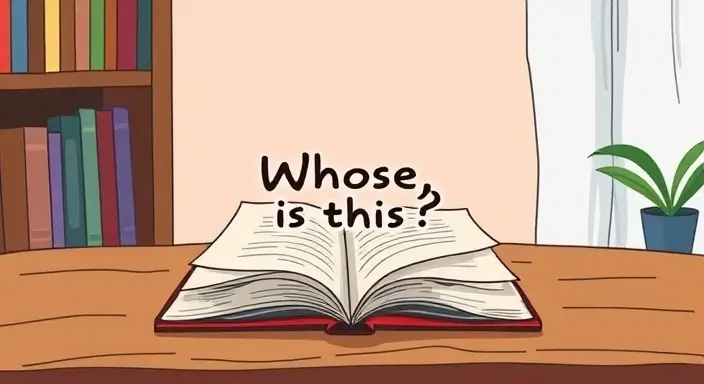Whose, possessive ‘s – Whose is this? It’s Anar’s
- Home ›
- Grammar ›
- A1 Elementary ›
- Whose, possessive ‘s – Wh...




Choose the correct option to complete the sentences.
Choose the correct forms: whose, who’s possessive ‘s, etc.
Rewrite the sentences using the possessive ‘s as in the example.
1 The balls belong to the players. ⇒ They are .

- 17 November, 2024
- 756
- Grammar
- A1 Elementary
Whose, possessive ‘s – Whose is this? It’s Anar’s
Introduction to Possessive 's
In English, we often need to show who owns or belongsto something. The possessive 's is a simple way to do this. Understanding how to use "whose" and possessive 's helps clarify ownership in sentences and allows us to ask about things or people that belong to others. This is especially useful when asking questions or giving short answers about possessions.
What is Possessive 's?
The possessive 's is a way to show that something belongs to someone. For example, if we say "Mike’s book," it means the book belongs to Mike.
In English, we add 's after a person’s name or a noun to show ownership or association.
Examples:
- John’s car (The car belongs to John.)
- Sarah’s house (The house belongs to Sarah.)
- The dog’s bone (The bone belongs to the dog.)
How to Ask About Possessions Using "Whose"
To ask about ownership, we use "whose" at the beginning of a question. This word is used when we want to know who owns or has something.
Examples:
- Whose book is this? – It’s Mike’s.
- Whose bag is that? – It’s Sarah’s.
- Whose pen is on the table? – It’s John’s.
The structure is simple:
- Use Whose at the start of the question.
- Follow with is/are (depending on if the object is singular or plural).
- Add this/that/these/those to indicate what you’re asking about.
Example Questions:
- Whose phone is this?
- Whose keys are these?
- Whose shoes are those?
Answering with Possessive 's
When answering questions that begin with "whose," we can use possessive 's to indicate who owns the object.
Example Answers:
- It’s Mike’s. (The phone belongs to Mike.)
- They’re John’s. (The keys belong to John.)
- It’s Sarah’s. (The book belongs to Sarah.)
Notice that in answers, we usually keep it short by only mentioning the name and adding 's.
Possessive 's with Plural Nouns
If we’re talking about plural nouns that already end in "s," we just add an apostrophe (') after the "s" instead of adding another "s."
Examples:
- The students’ classroom (The classroom belongs to the students.)
- The teachers’ lounge (The lounge belongs to the teachers.)
Common Mistakes to Avoid
- Mixing Up Possession with "is": Remember, it’s means it is, while its (without an apostrophe) shows possession for things or animals.
- Forgetting to Use 's: When talking about people or animals, always remember to add 's for possessive form.
Summary
- Use possessive 's to show ownership or association.
- To ask about ownership, start with Whose and follow with is or are.
- For plural nouns ending in "s," add just the apostrophe (') for possession.
- Be clear and specific with answers, keeping them short with the owner’s name + 's.
Practice Questions:
- Whose pencil is this?
- Whose shoes are on the floor?
- Whose cat is sitting on the sofa?
Practice Answers:
- It’s Emma’s.
- They’re Tom’s.
- It’s Jane’s.
Unfortunately, we currently do not have teaching materials available on this topic. We are working with all our efforts to prepare it. You can subscribe to Verbooze to be notified once the teaching materials are ready.




English Learning Made Easy & Accessible for Everyone
Boost your English skills with interactive lessons, grammar explanations, reading and listening exercises, and real-time feedback. Join our growing community and start improving today — all completely free!

